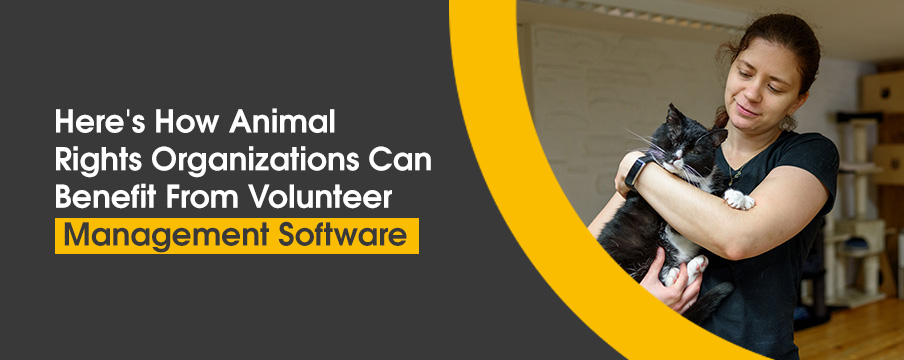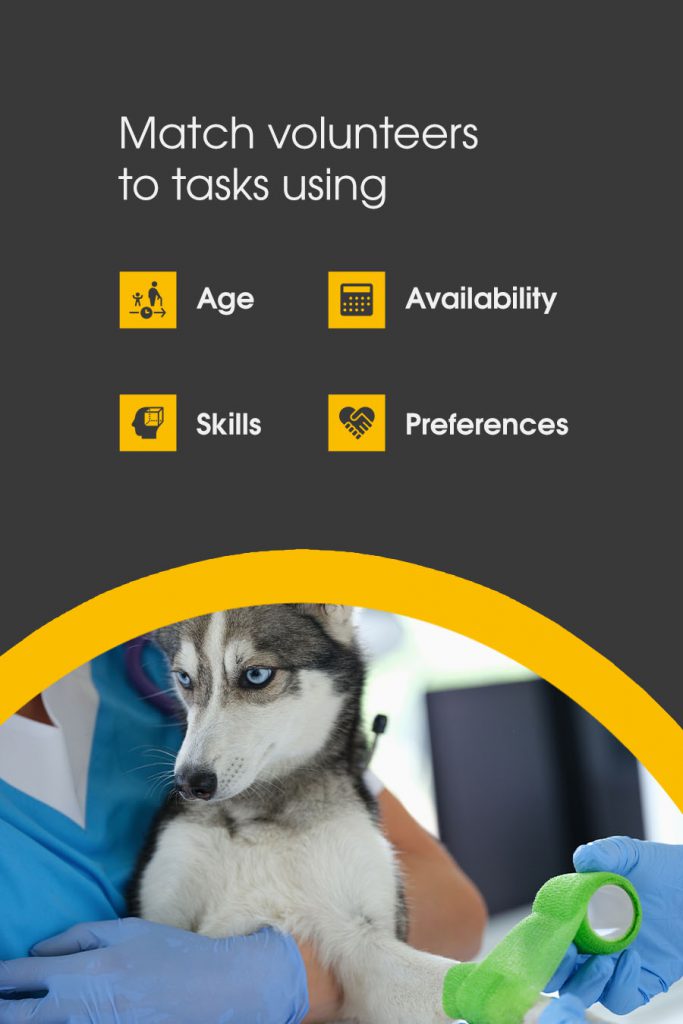Animal rights organizations and animal shelters rely on volunteers to manage donations, run events, and tend to the animals in their care. However, animal organizations experience various challenges that can make recruiting and retaining volunteers a complicated task.
Using volunteer management software for your animal rights organization can increase organizational efficiency. It can save administrators and volunteers time, money, and energy that could be better spent working with the animals.
Unique Challenges Animal Welfare Organizations Face
Because of the nature of their work, animal welfare organizations experience different challenges than most human rights organizations. Caring for abandoned and rescued animals is emotional for everyone involved, including the animals.
Having enough volunteers to clean enclosures, walk dogs, organize donations, and more is crucial to keeping the place running. As a result, administrators and volunteer managers must find ways to solve these challenges and keep volunteers active.
Inadequate Resources
Shelters and other animal rights organizations often experience shortages due to a variety of factors, including insufficient funding and lack of community engagement.
- Veterinary resources: Finding veterinarians with the proper training to deal with shelter environments may be challenging simply due to the nature of most veterinary schools’ curricula. With new animals constantly entering the shelter, inexperienced vets may feel overwhelmed.
- Staff training: Without sufficient training, trusting volunteers to care for animals can be risky.
- Staffing: Many animal shelters are severely understaffed as a result of COVID-19. Stretched resources and long hours lead to high turnover rates from volunteers, which leads to short-staffed facilities and increased stress.
- Facilities: Many shelters operate from aging facilities that are too small to prevent overcrowding — many others lack a physical space in general. Due to limited space, many organizations are forced to turn away animals they would otherwise accept.
High Volunteer Turnover
Overworked volunteers leaving the organization creates a vicious cycle for many animal rights organizations. Because shelters are already short-staffed, work becomes more stressful, which can cause volunteers to quit. Naturally, resources must stretch even further to maintain the same level of care.
Other common contributors to a volunteer’s decision to leave an organization can include:
- Stressful environment: Animal rescue and shelter volunteers can suffer emotional stress from seeing animals in pain and interacting with others in the same high-stress situation, which can lead to feelings of burnout if left unmanaged.
- Lack of control: Volunteers who feel that they have no power over their schedules and daily tasks are more likely to become discouraged — as a result, they’re also more likely to leave the organization.
- Lack of support: Organizations that deal with sensitive topics like the suffering of animals need to ensure that they listen to their volunteers’ suggestions. However, many lack the resources to do so.
Lack of Awareness
One of the biggest challenges animal shelters face is funding. However, it’s challenging to get sufficient financing when local communities are unaware of the situation. Or, in some cases, the surrounding communities are the cause of the shelter’s most pressing challenges.
For example, shelters in the United States take in approximately 6.3 million animals every year, according to the American Society for the Prevention of Cruelty to Animals (ASPCA). The majority are rescues or strays, which presents an additional challenge in that these animals have suffered trauma and need extra care and rehabilitation to be suitable for adoption. However, organizations need enough staff and resources to accomplish this task.
Additionally, many people are not aware of the various other services shelters provide. Additional services include providing underserved areas with affordable pet food and vaccinations, assistance with training and behavior problems, and access to spay and neuter services.
Raising awareness about the many functions animal shelters serve is crucial to bringing in more money for the organization, and it’s a key factor in recruiting more volunteers. A popular method of raising awareness is organizing special events or holding fundraisers.
6 Benefits of Volunteer Management for Animal Rights and Welfare Organizations
One of the most critical priorities of an animal rights organization — other than the animals — is recruiting and managing your volunteer force. Volunteers are the ones who carry out many of the day-to-day operations of animal shelters, so having a healthy number onboard is a must.
Implementing a volunteer management software program can take some of the back-end work off your shoulders, enabling you and your staff to spend more time rescuing animals and introducing them to their forever homes.
1. Recruit More Volunteers
The success of any volunteer organization relies on having enough people to fill open positions and carry out work. However, you need to find and attract the best-suited individuals to your organization to impact your community. For animal rights organizations, this means getting the attention of animal lovers and team players.
Volunteer management software can boost your recruitment strategy by streamlining the online recruitment process. Nowadays, most people find service opportunities through the internet, so it makes sense to maximize the potential for gaining new volunteers through your website. For example, Volgistics’ Opportunity Directory feature is a publicly available online space that provides interested individuals with easy access to information about current and upcoming opportunities.
You can easily embed your application form on your website, providing potential volunteers with a convenient way to apply. Your software can make things easier on your side by sending an automated confirmation response to the applicant that lets them know you have received their application.
After you receive the application, you need to ensure that the applicant is a good fit for your organization. A volunteer program with integrated background screening capabilities can help you decide whether to accept them without a long wait.
For example, Volgistics has partnered with Verified First to provide fast, accurate background checks of many kinds, including:
- Motor vehicle records (MVR) and Department of Transportation (DOT) records
- Criminal history
- Drug screening
- Civil records
- Credit and financial
- Identity services
Verified First’s speedy results enable you to bring new applicants on board quickly, which can help improve your organization’s outlook overall.
2. Maintain and Engage Volunteers
One of the top reasons volunteers leave is a lack of engagement in their work. Investing in your volunteer team by getting to know them allows you to place them in roles and situations where they will thrive, encouraging them to stay with the organization.
You can increase volunteer engagement by matching them with an assignment they both can and want to do. Volgistics’ volunteer management software includes database management capabilities that allow you to filter through database profiles based on the information you include.
You can match volunteers to tasks using characteristics like:
- Age: Many animal rights organizations and shelters require volunteers to be 18 or older to work directly with animals, but some allow younger people to help out at special events under adult supervision. Volunteer management software allows you to sort your applicants by age to ensure you’re assigning volunteers to age-appropriate tasks.
- Skills: Basing a volunteer’s assignment on their skills can enhance the volunteer experience. Including a field for skills can help you better determine where they’d fit in your organization. For example, you could receive an application from someone who works in marketing and social media — as long as they’re open to the task, they’d fit in well on a public relations or advertising team.
- Availability: Of course, you want to make sure you’re giving volunteers shifts that work for their schedules. An effective volunteer management program can hold this information in its database, providing easy access to what you need.
- Preferences: Some people may prefer working with cats to working with dogs, or they might feel more comfortable sorting through donations instead of interacting with the public. Taking these preferences into account when you schedule volunteers allows them to do work they love, increasing motivation and engagement.
3. Improve Scheduling
Your organization depends on a well-planned schedule to ensure that work gets done. Implementing a volunteer management system is an excellent way to stay on top of scheduling while simultaneously including your volunteers in the process.
A program that includes a self-service volunteer portal increases the level of control your volunteers have over their schedules. For example, the optional VicNet module from Volgistics allows volunteers to view and print their schedules from any internet-connected device, sign up for open shifts, and remove themselves from the schedule when their availability changes. Plus, volunteers and administrators can track hours, which is helpful for individuals who need to fulfill a community service requirement.
Other useful features include:
- Substitute tracking: This feature enables you to see in advance who is switching shifts and on what days.
- Perpetual scheduling: You can schedule volunteers for one-time shifts or ongoing intervals. For example, you can schedule someone every Sunday evening or on the first and third Wednesdays of each month.
- Openings view: You can create schedules with openings ahead of time and fill slots as volunteers sign up or become available.
These features are also helpful for administrators and volunteer managers, who frequently experience feelings of burnout and stress in their positions. A more efficient way to manage schedules can take some of the stress off your managers’ shoulders, which can reduce turnover rates and improve staff morale.
4. Streamline Communication
Effective and ongoing communication is crucial to the success of nonprofit organizations because it allows you to keep everyone on the same page at all times.
Best practices for getting in touch with volunteers include using the channels they use most often. For most Americans, these channels are email and text messages. Texting is an especially effective way to keep people engaged. Many people carry their phones with them at all times — they’re more likely to check their texts than log on to their email.
Using multiple channels is also beneficial to volunteers because it makes it easier for them to stay organized. They’ll know exactly where to find important information and communications without having to search through their work or personal inboxes to do so. Plus, they’ll know where to reach administrators and other volunteers, which can help foster stronger relationships within the organization.
You can also improve attendance by using text and email notifications to remind volunteers of upcoming shifts. Look out for the following capabilities when it comes to schedule reminder features:
- Automation: Using volunteer management software, you can contact all the volunteers in your database in only a few clicks. When you need to fill a shift last-minute or announce a change in plans, this function enables you to notify everyone ASAP.
- Intervals: Some programs allow you to set up repeating automated reminders on a daily or monthly basis. If you have people who serve regularly, this functionality can ensure they’re always on track.
The communication features in volunteer management programs also create an excellent opportunity to show your team members that you appreciate their service. You can send out thank-you notes, automated birthday messages, and other personal communication to remind them that their work matters and the organization cares about them.
5. Keep Better Records
Keeping thorough, organized records is essential for creating effective reports to demonstrate your shelter’s impact on the community.
You can easily track important data like logged hours, assignment histories, contact information, and other volunteer characteristics using volunteer management software. Maintaining this volunteer database is easy with cloud-based volunteer management software. You can access volunteer information from any location with an internet-connected computer.
The database management software also allows you to build comprehensive volunteer profiles using characteristics such as:
- Age
- Emergency contacts
- Location
- References
- Employers
You can also create custom fields to track information like the volunteer’s service preferences and the animals under their care.
Plus, when you need to impress donors, your software program can use the information within your database to generate informative reports with just a click. Volgistics allows you to generate reports for metrics like service details, volunteer lists, and even estimated service value in dollars.
6. Streamline the Volunteer Experience
High-tech time tracking solutions eliminate the need to manually log service hours, which allows you to spend less time on data entry and more time on important aspects of your organization.
Volgistics offers the optional VicTouch on-site kiosk to fulfill this purpose. VicTouch provides a convenient place for volunteers to check in for their shift as well as:
- Check their upcoming schedule and sign up for open shifts.
- View their service history.
- Receive messages from you.
- Check out when they depart.
The kiosk acts as a time clock, automatically tracking the volunteer’s hours once they check in. This function eliminates the need to manually log hours once the shift has ended, which increases data accuracy and saves time.
VicTouch is best for organizations operating from a single facility, like animal shelters. It works with Apple iPads, Android tablets, and touchscreen computers. You can also install more than one VicTouch system in your building if you have multiple check-in areas. For example, you can install a VicTouch at the entrance to each animal room.
Learn More About Volunteer Management Software for Animal Rights Organizations From Volgistics
If you’re looking for ways to simplify and streamline volunteerism at your animal rights organization, Volgistics can help. Volgistics is scalable to suit your organization’s needs — you’ll only ever pay for the features you need. And if your organization’s needs ever change, you can easily adjust.
Contact our support team today to book a free demo and see what Volgistics can do for your organization.





